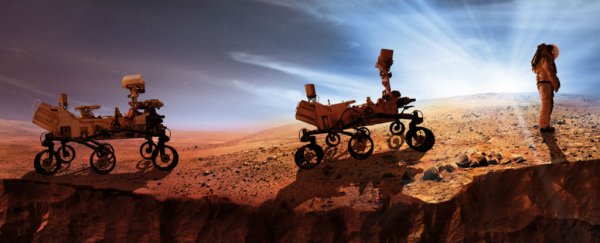With The Martian packing out cinemas and scientists finding strong evidence of flowing water on the surface of Mars, interest in the Red Planet has never been greater. NASA isn't losing any time in ramping up its plans to get people on the surface of Mars, and the space agency has just announced a three-stage plan for making manned missions a reality, with the first one tentatively scheduled for the 2030s.
Phase one is called Earth Reliant, and we're already well into it - it involves research projects carried out on the International Space Station (ISS), looking at how living in space for extended periods of time can affect the human body. Mars is about 140 times further away from Earth than the Moon is, and it's going to take us at least 150 days to get there (based on the capabilities of existing technology).
Other experiments being carried out on board the ISS at the moment cover 3D printing, advanced communications systems, and extravehicular operations. The aim is to develop technologies that enable us to go deeper into space for longer periods of time.
Phase two is called Proving Ground. "NASA will learn to conduct complex operations in a deep space environment that allows crews to return to Earth in a matter of days," says the official document. Most of this phase will be located in what's known as cislunar space, which is the space around the Moon.
On the agency's list of targets in phase two is another deep-space habitation facility to go alongside the ISS, as well as tests of the new Space Launch System (SLS). The SLS rocket and accompanying Orion spacecraft should enable us to go farther into space than ever before, and a launch has been pencilled in for 2018. Throughout phase two, NASA wants to see astronauts, space stations, and rockets reducing their reliance on Earth, although a quick trip back home will still be possible if necessary.
Then there's phase three, or Earth Independent - the name gives away what the idea is here. It includes manned missions to the Martian moons and eventually the Martian surface, and once we've set foot on the Red Planet tests and experiments can begin to figure out how best to establish life. By this stage, missions will need to be self-sustaining, with minimal reliance on people back home.
"Future Mars missions will represent a collaborative effort among NASA and its partners - a global achievement that marks a transition in humanity's expansion as we go to Mars not just to visit, but to stay," says NASA. The first settlers will eventually need to be able to create their own fuel, water, oxygen, and building materials from the resources available on the Red Planet.
Of course, there are a lot of challenges along the way, from refining the technology required to get us there to making sure the astronauts remain healthy on the way, but NASA's plan is firmly in place. The full document is well worth a read if you want to learn more about how manned missions to Mars will soon become a reality.
